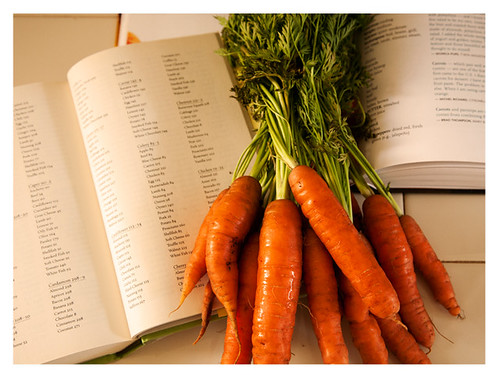Currently Reading: Flavor Resources to Use When Creating Recipes
Farmer's markets present a plethora of amazing produce to choose from. As a visual person, I'm often drawn to colors and shapes before I even know what something is or how to cook with it. If you're like me and find yourself with a bag full of farm fresh produce and no idea what to cook, you'll want to have a few references on hand to help you out.

I've found the easiest way to learn how to do something is to just dive in. Sure you'll make a few mistakes here and there, but once you've got some basics mastered, you'll be just fine. The same goes with whipping up recipes on the fly--a must have skill if you're looking to eat more local, in season ingredients.

A pile of ingredients fresh from your CSA box or the farmer's market is like a blank page. If you're a writer, you get past your writer's block by just starting to type. For me, when I'm overwhelmed by a pile of ingredients, I start by focusing on one and picking up a cookbook. Not just any cookbook, but either The Flavor Bible: The Essential Guide to Culinary Creativity, Based on the Wisdom of America's Most Imaginative Chefs (*affiliate link) or The Flavor Thesaurus: A Compendium of Pairings, Recipes and Ideas for the Creative Cook
(*affiliate link).

Using Flavor References to Create Dishes
My two favorite "cookbooks" aren't filled cover to cover with recipes, what they are filled with are pairings, lists of what ingredients work together. Along side the pairings are tips about how to prepare various combinations.
The Flavor Bible includes helpful tips from world-renown Michelin star chefs. One tip that provided most helpful when I created my Chilled Carrot Ginger signature soup last June for La Crema Winery) was to add raw carrot juice to give your soup more of an orange color. Cooked carrots are pretty colorless.

The process that follows is how I determined what ingredients to include in my soup. The lists of ingredients in the photos are my actual notes from the recipe creation process.
To craft a dish with a harmonious symphony of flavors:
- Determine what the main ingredient in your dish will be. Often this is just determining what you have the most of or what is about to spoil if you don't use it now.
- Open your flavor reference up to that ingredient. (If you're using the Flavor Thesaurus, look your ingredient up in the Pairings Index.)
- Scan the list of pairings for the other ingredients you have on hand.
- Compile a list of the recommended pairings that match your ingredients.
- Repeat steps 2 and 3 for your next ingredient.
- In the list of ingredients you've written down, highlight or circle those that are also recommended for your next ingredient.
- Repeat steps 5 and 6 until you have gone through all of the ingredients you'd like to use.
- Examine your circled or highlighted ingredients. Those with the most marks should be considered for your strongest notes. Those with fewer marks should be added to taste to determine whether or not you've found a taste combination that's a potential hit.
- Start cooking, and have fun!

Four Must Have References For Recipe Creators
The four books I find myself flipping through when faced with a new-to-me ingredient I've picked up in the Farmer's Market or a forgotten or incorrectly grabbed ingredient (arugula instead of spinach a couple of years ago) are:
- The Flavor Bible: The Essential Guide to Culinary Creativity, Based on the Wisdom of America's Most Imaginative Chefs
(*affiliate link)
- The Flavor Thesaurus: A Compendium of Pairings, Recipes and Ideas for the Creative Cook
(*affiliate link)
- Herbs & Spices: The Cook's Reference
(*affiliate link)
- Taste What You're Missing: The Passionate Eater's Guide to Why Good Food Tastes Good
(*affiliate link)
P.S. Don't feel like commenting? Strike up a conversation with me elsewhere: Twitter, Instagram, Facebook, Google+, or Pinterest.
Credits: All layouts designed by and images taken by Eden Hensley Silverstein for The Road to the Good Life.
This post contains affiliate links followed by (*affiliate link). I feature products that I own or that I am considering purchasing. I own all of the books mentioned in this post. All opinions presented are my own.
